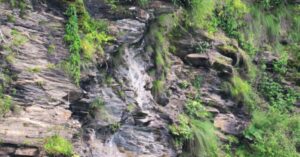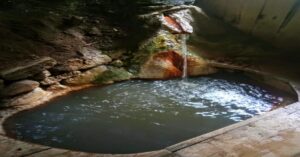Chubu Tshachu is a hot spring discovered by Guru Rinpoche in the 8th century. It is located at the foot of the spire-shaped hill, the abode of Tsachu Deity, Ap Khachhep, at an elevation of 1737 meters above sea level in Wolathang of Toedwang Gewog under Punakha Dzongkhag.
Chubu Tshachu is one of the most well-known hot springs in Bhutan. It is supposed to have derived from its geographical position at the confluence of two rivers, the Pho Chhu and the Mo Chhu. Chubu (Chhu- water, Bu-centre) means “Water in the Centre”.
The most popular hot springs in Bhutan are the Chubu hot spring and Koma hot Spring in Punakha; the Duenmang hot spring in Zhemgang; the Khempajong nye hot spring in Lhuntse; the Gasa hot spring in Gasa; and the Gelephu hot spring in Sarpang.
Also Read: Hot Springs in Bhutan: Bhutanese Beliefs and Benefits
How to Reach Chubu Tshachu
The Chubu hot spring is located approximately 30 km away from the suspension bridge in Punakha. Drive to Khuruthang Town and cross the Khuruthang bridge over Phochu-Mochu, turn left towards the distant hills along the Phochu river bank until you reach another bridge over the same river that takes you to the other side. The place where this Phochu bridge is located is known as Samdingkha.
The distance from Khuruthang to Samdingkha is about 13 km. To go to Tsachu from Khuruthang, take a taxi, preferably a Bolero jeep. There are a few Boleros at the Samdingkha Parking Lot, but hire is not guaranteed on the spot.
The road from Samdingkha to Chuba Tsachu is rough and tough along the hillside facing the meandering Phochu below. Cross the Phochu bridge at Samdingkha and drive up the road for a short distance till it forks two ways. Turn right towards the river view. The road climbs steadily, but at times takes a dip too. There are no reliable road signs at road junctions. The road snakes along the hill range that faces the Phochu River. Towards the journey’s end, the road turns inward away from the Phochu River and enters the small valley known as Tsaphu. The last village is called Nepdingkha, also now referred to as Tsaphu village.
Also Read: How to Trek to Dur Hot Spring in Bumthang
Trek Route of Chubu Tshachu
- Start from Khuruthang Town, Punakha;
- Khuruthang Town to Samdhingkha: About 13 KM and 1 ½ hours’ drive by car;
- Samdhingkha to Chubu Tshachu: the distance is about 17 kilometers and will take 2 and a half hours to 3 hours.
The Origin of Chubu Tshachu
Even today, the origin of Chubu Tshachu is not well documented. However, history has it that Guru Rinpoche discovered the hot spring during his visit to Bhutan.
Also Read: Guru Rinpoche in Bhutan: His Visits to Bhutan and Sacred Sites
According to legend, Dralay Gyelpo, the site’s current local deity, volunteered to provide all of the timber needed for the construction of Punakha Dzong by Zhabdrung Ngawang Namgyel in 1627.
He provided the timber through the Pho Chu River but was distressed because Zhabdrung Ngawang Namgyel had not provided any details about the timber’s sufficiency. He inspected the Dzong site with great trepidation, but all the wood was stacked on the river’s path in a lake called Lhamochey, so he stopped sending timber.
Meanwhile, Zhabdrung sent Dralay Gyelpo a message chastising him for failing to deliver the timber on time and warning him not to reveal himself publicly. Since then, Dralay Gyelpo has lived at the hot spring site, becoming its local deity and remaining concealed from the public.
In the region, he is now known as Khachaep Dralay Gyelpo. The figure of this Deity, with his face half black and half white, can still be seen in the Goenkhang of Ngyerchu Lhakhang today.
Also Read: The Origin of Gasa Tshachu
Description of Chubu Tsachu
There are 10 hot springs in the country. The Chuboog hot spring in Punakha, the Duenmang hot spring in Zhemgang, and the Gasa hot spring in Gasa are Bhutan’s three most popular hot springs.
The hot spring complex has a well-paved, easy-to-walk concrete footpath from the starting point (entrance to the complex) that forks 2 ways to the two different pool sites.
There are two hot water ponds at the Tshachu site. The upper pool (Gongma) with a temperature of 39.9°C is categorized as a warm spring. This pond is divided into 4 open compartments formed by timber beam dividers at the pool surface level of a single large pool.
The lower pool, known as Wogma, with a temperature of 43.5 °C, is categorized as a hot spring. This pond is under one roof with two different pools. One small pool and another larger pool are divided into 9 open compartments.
All pools are properly roofed, and the surrounding floors are concreted. The pools have wooden floors and the larger two have wood-paneled sides to conserve heat and provide health comfort.
There are compartments for bathing before entering the pool to soak in the Tshachu. One must scoop water from the pools in buckets or jugs and carry it to the bathing room. Quite convenient actually since bathing cum changing compartments are under the same hall that houses the respective pool.
Also Read: Description of Gelephu Tshachu
Therapeutic Values or Ethnopharmacological Benefits of Chubu Tshachu
Chubu Tshachu, like all the country’s hot springs, is also renowned for its soothing and curative properties for ailments.
The upper pool is thought to heal serous fluid associated with cold disorders, which include urinary tract infections and sexually transmitted infections (STIs). It is also helpful to those suffering from chronic stomach aches, skin diseases, and other diseases related to evil afflictions.
The lower pools are known for treating stomach ailments, muscle sprains, diabetes, and some forms of phlegm diseases. It also helps heal indigestion, cold disorders, and increased mucus because of suppressed wind and weak, and painful eyes.
Also Read: Therapeutic Values or Ethnopharmacological Benefits of Duenmang Tshachu
Accommodation at Chubu Tsachu
Chubu Tsachu has six bathrooms, one bathing pool, six local stores, and ten guesthouses. There are 2 sets of male and female-designated toilets between the tent accommodations and hot spring pools.
Also Read: Accommodation at Koma Tshachu
Contact details of Chubu Tshachu
If you’re planning a family trip to Chubu Tshachu or with your friends, here’s the contact number of the hot spring focal person. Please contact the focal person at 17648950 before you plan to stay and relax in the Tshachu. Chubu Tshachu’s price depends on your duration of stay and the pool.
Best Time to Visit Chubu Tshachu
The best time to visit Chubu Hot Spring is during the winter months from October to early March. You can visit Hot Springs in Bhutan with the Bhutan Pilgrimage Package.
Places to Explore in Punakha
Punakha Dzong: Also known as Pungtang Dewa Chhenbi Punakha Phodrang, which translates to “the palace of great happiness or bliss,” it is the administrative center of the Punakha District, constructed in 1637 by Ngawang Namgyal.
Chimi Lhakhang: Also known as the fertility temple, it is a Buddhist monastery in Punakha constructed on the site where Drukpa Kunley subdued a demoness. The monastery was founded in 1499 by Lam Ngawang Chogyal.
Goen Tshephu Ney: It is a sacred cave of longevity in Punakha, considered the third Draphu Maratika. Guru Rinpoche meditated in the cave for three months and visualized Buddha Amitayus, the “Buddha of Long Life”.
Kabji-Hoka Tsho: It is a sacred lake in Punakha with an opening in the lake created by the lake’s deity after a demon threatened to flood the area. The hike to Kabji-Hoka Tsho is considered to be of medium difficulty. It takes two to three hours on foot from Chorten Nyingpo Lhakhang.
Punakha Suspension Bridge: It is one of the country’s longest suspension bridges, spanning approximately 180 meters over the Pho Chhu River. The bridge connects Punakha Dzong with Punakha town and nearby villages.
Khamsum Yulley Namgyal Chorten: It is a Buddhist monument in Punakha on a hilltop overlooking the Mo Chhu River, constructed in 1992 to ward off evil spirits and to bring peace and harmony to all living beings.
Enjoyed reading this blog?




